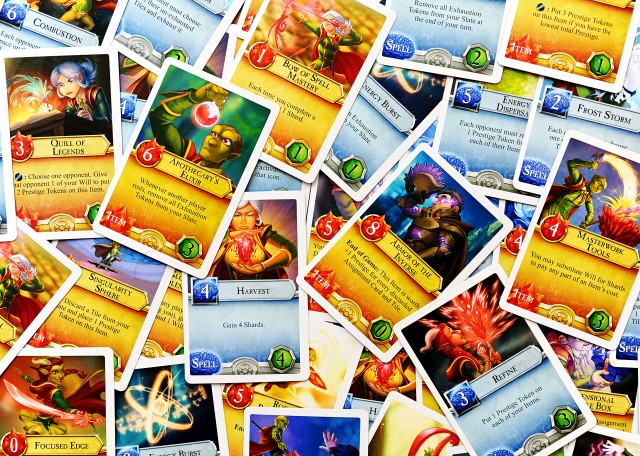In the fantasy world of Gossamyr, battles are not fought with warriors on a battlefield. The weapons being wielded aren’t made of sharpened steel. This is a land where magic reigns supreme and the fight is lead by students and prodigies that have mastered the arcane arts. In Arcane Academy, you enter school to work on your magical skills in preparation for any existential threat that may arise. You’ll study and complete assignments to earn prestige, but only one student will graduate at the top of the class.
Arcane Academy is the new collaboration between Eric M. Lang and Kevin Wilson. It’s played out over a series of turns and features a simple and accessible set of rules. Everyone start with their own personal Player Slate. It’s a board that will be used to store new tiles and execute your actions. There are twelve spaces on the board to hold tiles set up in a 4×3 grid. The corners of the grid are already filled in with some starting actions that players can take.
 Over the course of the game you’ll acquire new tiles, gain Will and Shards (the currency of the game), and complete assignments. Although everyone starts with the same boards, it won’t be long before each one has taken its own look and functionality. As your board takes shape, you’ll have the ability to Link tiles together. How you construct your board will be critical to your success as a student in the Arcane Academy and can lead to powerful, dynamic turns.
Over the course of the game you’ll acquire new tiles, gain Will and Shards (the currency of the game), and complete assignments. Although everyone starts with the same boards, it won’t be long before each one has taken its own look and functionality. As your board takes shape, you’ll have the ability to Link tiles together. How you construct your board will be critical to your success as a student in the Arcane Academy and can lead to powerful, dynamic turns.
On a turn you’ll either take an action or rest. When you take an action you select one of the tiles on your board and place an exhaustion cube on it. You then get that action and any other that is directly linked to the original. Even though you get to perform the linked actions, you don’t have to place an exhaustion cube on them, leaving them available for subsequent turns. You can execute the actions in any order you’d like and, as is often the case, order can be important!
There are five possible actions to perform as well as a wild action that allows you to choose any one. Collecting Shards or Gaining Will increases your total in one of the two currencies of the game (Shards are used to gain Items and Will to cast Spells). Use Item allows you to activate one of the Items you’ve gained during the game. Complete Assignment gives you the chance to exchange Shards or Will to complete either an Item or Spell and place it in front of you. Finally Add Tile allows you to take one of the available tiles and add it to your board. Once placed a tile may never be moved, but you can cover up previously placed tiles.
Many of the tiles have one or more sides that have a connector on it. If two tiles touch  orthogonally with connectors on either side, they are considered linked. When one of the actions is taken, the other can also be used as long as it wasn’t already exhausted from a previous action.
orthogonally with connectors on either side, they are considered linked. When one of the actions is taken, the other can also be used as long as it wasn’t already exhausted from a previous action.
Resting simply allows players to sweep off their exhaustion cubes and start fresh on the next turn.
As your collection of Spells and Items grows you’ll be able to execute more powers and have more dynamic turns. Many of them have ongoing or triggered effects that will help you along the way. Spells and Items are also the timer for the game. When one player has completed their eighth assignment, game end is triggered.
I think one of the things I like the most about this game is how completely unexpected it is. Arcane Academy is not the game I envision when I think of Kevin Wilson and Eric M. Lang. It’s totally fun, without having a mountain of rules. That’s not to say that their games are tough to learn or inaccessible, they are just a bit more complex then some of the titles out there. These two brilliant designers show that a good foundation is all you need to come up with an awesome game. This is one that players of all skill levels can sink their teeth into and I’m not exaggerating when I say that Arcane Academy is one of the best games I’ve played this year.
I love when I see designers step out of (at least what I consider) their comfort zone. Lang and Wilson have designed some of my favourite games of all time, so it’s great to know that they can still pull some magical surprises out of their bag of tricks. Definitely check out Arcane Academy when you get a chance!
Comments
No comments yet! Be the first!